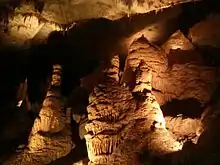Cumberland Caverns
Cumberland Caverns is a national natural landmark and show cave located in McMinnville.[2][3] It is the second longest cave in Tennessee and makes the list of longest caves in the United States and in the world.[4][5][6]
| Cumberland Caverns | |
|---|---|
| Higgenbotham Cave, Henshaw Cave | |
 Cumberland Caverns - Three Chessmen | |
| Location | McMinnville, Tennessee |
| Coordinates | 35°40′09″N 85°40′51″W[1] |
| Length | 32 miles (51 km)[2] |
| Discovery | 1810 by Aaron Higgenbotham |
| Geology | Monteagle Limestone |
| Entrances | 3 |
| List of entrances | Higgenbotham Cave, Henshaw Cave, Onyx Curtain |
| Access | restricted |
| Show cave opened | 1956 |
| Lighting | electric |
| Website | cumberlandcaverns |
History
The main entrance was discovered by Aaron Higgenbotham in 1810 while he was surveying the nearby Chickamauga Trail on Cardwell Mountain in what is now Warren County. According to legend, Higgenbotham was the first man to enter the cave and it was named Higgenbotham Cave in his honor. Another smaller cave, also located on Cardwell Mountain, was also discovered about this time and was named Henshaw Cave. Although not nearly as big as Higgenbotham Cave, Henshaw Cave proved to be a source of saltpeter (the main ingredient of gunpowder) and was operated as a saltpeter mine during perhaps both the War of 1812 and the Civil War.
Higgenbotham Cave became a favorite spot for local adventurers during the 19th century and groups would ride out to the entrance in hay wagons and make the strenuous trip to a point in the cave now known as the Ten Acre Room. In the days of the hay wagon parties, it was called the Big Room. Here, many visitors left their names and the date candled on the ceiling.
In the early 1940s, members of the National Speleological Society (NSS) began to explore Higgenbotham Cave. Within a decade, they had greatly increased the known extent of the cave. In 1953 a connection was discovered between Henshaw Cave and Higgenbotham Cave. This connection was named the Meatgrinder because of its small size and shape. Soon afterwards, some of these explorers leased the cave from its owner, Mr. Andy Powell, and developed it into a commercial cave. The cave opened under the name Cumberland Caverns on July 4, 1956 and has been open to the public since that time.[7]
A portion of the Trail of Tears passes through Cumberland Caverns property. A walking trail is open to the public.[8]
Commerce
The Cumberland Caverns company offers year-round commercial tours of the cave, claiming it is the largest show cave in Tennessee. Tours include a daytime walking tour, spelunking tours, overnight tours, and educational field trips. Weddings, banquets, and birthday parties are also hosted. Before reaching the cave, tourists pass through a gift shop that sells tour tickets, souvenirs, and novelty items.[2]
Cumberland Caverns Live
Cumberland Caverns was formerly home to Bluegrass Underground, a monthly music event that took place in the cave's Volcano Room. The event has become a nationally syndicated program airing on PBS.[9]
Now, the Volcano Room is home to Cumberland Caverns Live and hosts a variety of concerts and live music, including acts like Sister Hazel, Kip Moore, and Deer Tick (band).
Geology
Cumberland Caverns formed in Mississippian Monteagle limestone on the western escarpment of the Cumberland Plateau.[10] The cave is home to stalagmites, stalactites, helictites, flowstone, cave pearls, botryoidal coral, gypsum flowers, needles, and pure white gypsum snow, as well as a variety of cave life.[11]
Formations of interest within the cavern include:
- the "Volcano Room," where many of the cave's commercial events are hosted.
- "Monument Pillar," a large flowstone formation.
- "Crystal Palace," which contains crystals and gypsum flowers.
- three spelunking tunnels known as "the Devil's Backbone" due to their winding spine-like walkways.
- the "Lemon Squeezer," so named because its widest point is only 11 inches (280 mm).
- "Bubblegum Alley," a passageway similar in size to the Lemon Squeezer but with damper ground that makes it sticky.
- "the Hall of the Mountain King," whose dimensions of 600 ft (180 m) long by 150 ft (46 m) wide by 140 ft (43 m) tall make it one of the largest cave rooms in eastern North America.
Popular culture
The 1985 movie What Waits Below was filmed in Cumberland Caverns.[12]
A Children's Education DVD by singer/songwriter Buddy Davis "Amazing Adventures: Extreme Caving" was filmed in Cumberland Caverns[13]
References
- Barr, Jr, Thomas C. (1961). Caves of Tennessee, Bulletin 64. Nashville, Tennessee: State of Tennessee, Department of Conservation and Commerce, Division of Geology. pp. 470–482. ISBN 9780979617805.
- "Discover Cumberland Caverns". Cumberland Caverns. Retrieved 10 March 2015.
- "National Natural Landmarks - National Natural Landmarks (U.S. National Park Service)". www.nps.gov. Retrieved 2019-03-28.
Year designated: 1973
- Gulden, Bob (June 17, 2014). "USA LONGEST CAVES by STATE". NSS Geo2 Committee on Long and Deep Caves. Retrieved 10 March 2015.
- Gulden, Bob (January 1, 2015). "USA LONGEST CAVES". NSS Geo2 Committee on Long and Deep Caves. Retrieved 10 March 2015.
- Gulden, Bob (January 1, 2015). "WORLDS LONGEST CAVES". NSS Geo2 Committee on Long and Deep Caves. Retrieved 10 March 2015.
- Matthews, Larry E. [1989] 2005 Cumberland Caverns ISBN 0-9615093-4-1
- "Field Excursions: Cumberland Caverns takes bluegrass music to a new level—underground". Nooga. Archived from the original on 2 April 2015. Retrieved 9 August 2015.
- "PBS Arts Gallery." PBS. Accessed 28/12/2012.
- Crawford, Nicholas (1981). "Guidebook to karst and caves of Tennessee: emphasis on the Cumberland plateau escarpment region". Eighth International Congress of Speleology: 14. Archived from the original on 2 April 2015. Retrieved 28 February 2015.
- "Cumberland Cavern (Higginbotham and Henshaw Caves)". National Natural Landmarks Program. National Park Service. June 28, 2012. Retrieved March 10, 2015.
- "What Waits Below." IMDb. IMDb.com, n.d. Accessed 29/12/12.
- "Go Spelunking with Buddy Davis in Cumberland Caverns". Answers in Genesis. Retrieved 2020-01-27.